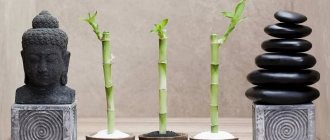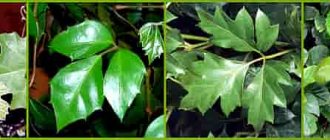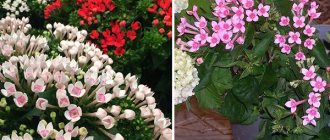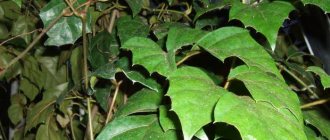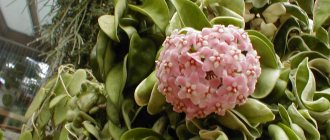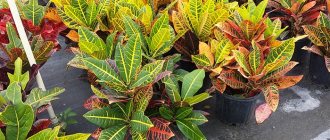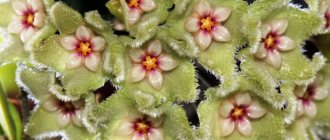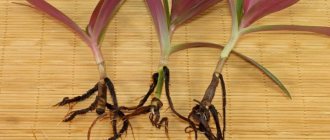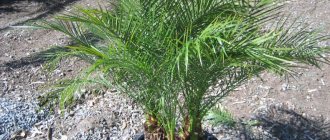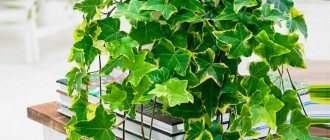Hoya is a liana that, since its discovery on the Polynesian islands, has become overgrown with legends, superstitions and signs. For centuries, the most unusual properties have been attributed to it. At one time it was rumored that wax ivy brought family misfortunes and promised family breakdown.
Subsequently, the opinion about the magical properties of hoya changed and it began to be considered a symbol of financial well-being.
Nowadays, all charges against Hoya have been dropped, and designers and gardeners love it for its very spectacular, wax-covered flowers and ease of care. Now this liana is very popular and its various varieties, in all their diversity, are easy to find in flower shops.
Growing
There are some features when breeding this flower:
- Hoya loves light, so it is advisable to keep it on the south side. But at the same time, it should not be left in direct sunlight for a long time. It is necessary to create shade, otherwise burns will appear on the leaves.
- If the hoya gets enough light, you will soon see flowers on it. If buds appear, then it does not need to be moved to another place.
- It is better to protect this plant from drafts and sudden changes in temperature. Also, you can’t keep it in the cold. If the temperature is less than 10 degrees, the flower will die.
- It will be good for hoya if the soil where it is located is fluffy and light.
- In order for the plant to develop normally, it must be constantly fed with fertilizers.
- The soil should not be completely dry; as soon as it dries, it should be watered immediately.
- This plant loves to be sprayed.
Some types of hoya are very capricious in relation to the soil, and there are also those who will not be able to develop normally at temperatures less than 20 degrees.
What kind of plant?
Hoya, hoya (Hoya), wax ivy is an evergreen vine from the family Asclepiadaceae. This plant was named after Thomas Hoy, who was a gardener in England who devoted his life to growing flowers. At this time, there are approximately two hundred species . Under natural conditions, the Hoya vine can be found growing on rock slopes, tree trunks, and small mountain ranges in Southern China, Australia, and India.
The plant itself fascinates with the extraordinary beauty of its flowers, and some of the subspecies may have a sweet aroma. Most often, hoya leaves have an oval shape with a slightly pointed end, but they can also be slightly rounded or, conversely, more elongated.
They can be a pure dark green saturated color, or they can be green with small white splashes. The hoya leaf is very dense and fleshy. The inflorescence of the plant resembles a fluffy bunch as it hangs from the main stem. On the “cluster” there are flowers like two stars with five rays. One “star” is large, and the other is smaller, located in the middle. The color of the first and second “star” may differ .
Hoya in home floriculture
In order to grow this flower at home, you need to choose its size. Many types of hoya grow large. But you can also choose those that fit easily on the windowsill.
The plant can simply be hung or placed in a certain place, and the branches will curl around the pot. While the plant is young, its stems are flexible and elastic, but then they can break if you try to bend them.
This flower is easy to care for and can be grown at home. In any case, this plant will always reward you with its decorative appearance, which will remain so as long as it is properly cared for.
Kinds
Hoya majestic / Hoya imperialis
The main habitat is the peninsula. Malacca. This species is a climbing shrub with pubescent shoots. The leaves are oblong, oval in shape, up to 20 centimeters in length. The leaf blades are smooth, rounded at the base, briefly pointed at the apex, and leathery. Pubescent petiole up to 7 centimeters long. The flowers hang in an umbrella of 7-10 pieces, up to 20 centimeters long, dark red inside and yellow-green outside; the crown is pubescent briefly with petals arranged in the form of an asterisk on pubescent short pedicels; they smell very nice.
Hoya multiflora / Hoya multiflora
Lives in Malaysian forests. The plant climbs and has linear, oblong leaves. It has numerous umbrella-shaped yellow flowers. Crown with rounded teeth. Petals are narrow.
Hoya fleshy (Hoya motoskei) / Hoya carnosa (Hoya motoskei)
Or Hoya motoskei. It lives in Australia and tropical subtropical zones of Asia, mainly on rocks and forests. These are vines reaching a length of up to 6 meters, with creeping pubescent stems. The leaves are ovoid; are oblong and heart-shaped; up to 8 centimeters in length and up to 4 in width; dark green; the petioles of the leaves are short, and the leaves themselves are fleshy and shiny; the apex of the leaf is briefly pointed, but more often blunt. The flowers are collected umbellately; white or pale flesh-colored, with a pink crown in the center. The flowers are held on slightly pubescent pedicels, the length of which is up to 4 centimeters. The five-membered corolla, one and a half centimeters in diameter, has a pleasant aroma. The corolla lobes are densely pubescent on top, wide, and their edges are twisted. Hoya fleshy blooms well during the growing season (from spring to late summer), and is grown both in greenhouses and in rooms.
Hoya beautiful / Hoya bella
Grows in the forests of Burma. These are small shrubs with creeping thin shoots, densely covered with leaves. The leaves are lanceolate, ovate, small, up to 2.5 centimeters in length, dense, slightly convex, pointed at the apex. The flowers are small and hang like umbrellas; 1.2-1.5 cm in diameter, white, waxy, divided into 5 lobes, with a purple-red crown. Blooms densely throughout the summer. In warm rooms it is often used as an hanging plant. Hoya beautiful is a very ornamental plant.
Hoya in different seasons
This plant blooms even in winter. If you want to create such beauty for yourself, then you need to prepare the flower for this in September. To do this, place the container with the plant on the east side.
At the beginning of winter, the flower is watered very little, and as a result, flowers appear on the plant. The most ideal temperature for this period of time is 15 degrees Celsius.
There are also types of hoya that do not like coolness; these include multiflora. If the temperature is below 20 degrees, then it loses leaves and flowers.
As a rule, winter is an opportunity for Hoya to rest, and at this time it is better to water and fertilize it less. It blooms in the warmest times of the year, just when it needs constant care. And all this time the flower needs light.
Botanical description
The Kutrov family includes the genus Hoya (lat. Hoya) , which has up to 200 species. Distributed in tropical Australia, some parts of India and the Malay Archipelago. The genus name was given to the plant in honor of Thomas Hoy. The genus is represented by evergreen plants with creeping and climbing shoots. The leaves are oval, ovoid, leathery, fleshy; axillary inflorescences. The corolla has five members, round and fleshy. The flowers form an umbrella. Crown of five convex, thick, dissected columns. Indoor hoya is a very unusual ornamental plant. They grow in both warm and moderate and cool rooms - they tolerate dry air well. For good growth, Hoya needs to be given support.
Watering a flower
When it is very hot, this flower needs to be watered abundantly, because it is precisely at this time that it grows. But in autumn and winter this is done less. Watering should be done with settled and soft water when the soil on top dries out.
To induce flowering, the plant can be placed in a bucket filled with warm water at 30-35°C. You need to fill it to the top of the pot and leave it there for 1 hour. After this, the container with the flower is removed and placed in the place where it already stood.
Propagation by cuttings
Rooting of cuttings occurs productively if favorable conditions are created, namely high humidity and the required temperature. This method is the most common. Various methods are used to root cuttings:
- With the help of water.
- To do this, you need to remove the leaves from the nodes on the cutting, treat it with a root hormone and place it in water.
- The selected container must be placed in a warm place (about 22 degrees), maintain high humidity (can be covered with plastic wrap or a bag, a greenhouse effect will be formed as in greenhouses).
- It is necessary to transplant the emerging roots into pots before they grow long, because the cuttings become fragile and can break off. The roots will be visible in two weeks.
- Using a solid substrate (porous soil mixture, perlite, vermiculite, moss), the cuttings are treated with a special powder and then planted. The required humidity should be maintained, but moisture evaporation should also be prevented.
- Using a peat tablet : to do this, you need to moisten the tablet and place the dried cuttings in a small hole in the tablet. After 2 weeks, when the roots appear, you can plant them together with the tablet in a pot.
Choosing a pot and soil
A small pot is enough for this plant to thrive. Its usual environment is large trees and rocks. Therefore, when planting this flower at home, you need to plant it in small containers where air can flow well. In the photo you can see how hoya looks great in a small pot.
It doesn’t matter what the container is made of, any material will do. The soil where the plant will move should preferably be loose, with the addition of humus from the leaves. As a rule, many types of hoya grow quietly in any soil. But some varieties require limestone in the substrate.
Varieties
Carnosa
Description - this species has dark green leaves, on which there are inclusions of white to silver shades. There are variegated varieties that may have multi-colored stripes in the center and along the edges of the leaf pulp. The inflorescence of the plant is collected in a cluster, which can have up to twenty flowers of white shades with red in the middle.
Features - Hoya flowers can secrete nectar so much that it can drip. This species also has a feature associated with daylight hours. By the evening, the aroma from flowers may be more intense than during the day or in the morning. The plant is also capable of forming new inflorescences directly on the old one.
You can watch a review of Hoya Carnose in this video:
Kerry
Description - this type of plant will most need additional support, since the leaves are quite large in diameter and can be half the size of an adult’s palm. This plant is also called “green heart” because the leaves are heart-shaped. There are also variegated varieties. The inflorescences are white and red.
Features - usually for Valentine's Day, hoya is sold in pots of one large leaf . If you take care of the leaf, water it or make a small greenhouse, then soon it will give roots and new shoots, and after a while it will grow into a large and beautiful vine.
You can watch a review of Hoya Kerry in this video:
Compacta
Description - this species is a variety of the Hoya carnosa species. The dark green leaves have a curled appearance and can therefore be associated with curled hair. There are varieties that have two-color leaves. Leaves grow on liana branches. The inflorescences are small and compact, as is clear from the name of the plant. They have a pale pink tint.
Features - the main feature is the type of foliage of this species. It is extremely rare to find such curled leaves as those of this plant .
You can watch a review of the Hoya Compact in this video:
Lacunosa
Description - this species is otherwise called “curved” because the leaves are slightly curved at the edges, it has dark green foliage with white specks. The inflorescences in the cluster are white, round, “hairy” with a small star in the middle, yellow to cream in color. This vine grows very quickly in length.
Features - the advantage of Lacunosa is the delicate aroma from the flowers , which can fill the entire space of the home.
Linearis
Description - the type of plant has intricately shaped leaves that look more like sharp needles. The foliage is gray-green in color with a small edge. The inflorescences are cluster-shaped, cream and white in color, with small fibers.
Planting and transplanting
Transplantation should be done no more than once every two years.
The fact that this flower has adventitious roots makes this process easy. To do this, a well-developed flower stem is placed in a container with soil and secured with wire. After the shoot has given roots, it is separated from the main plant.
When a flower is transplanted to a new place, the container should be slightly larger than the one from which the flower is transplanted. Hoya blooms only when its roots completely fill the entire space in the pot.
There must be a good drainage layer so that the water drains well after watering. The soil must be sufficiently loose and fertile; for this purpose, special mixtures can be used.
What is it sick with?
Spots on leaves
- Yellow spots are a sign of lack of light.
- If you see a black or brown spot, rub the leaf with your fingers. If the stain is erased, then it is a fungus. Treat with a fungicidal agent. If it remains on the leaf, it is a viral infection. Isolate Hoya Retuza from other plants and treat with an antiviral drug.
Insect pests
Parasites settle on roots, stems and leaves.
- Root nematodes are microscopic worms. The roots rot from them. Remove the plant from the ground, wash the root with hot water, and treat with an insecticide. Then replant in new sterile soil.
- Scale insects and whiteflies suck sap from leaves and stems. They look like small reddish cocoons. Treat Hoya with an insecticide every 2 weeks until it recovers.
The health of this species is good; the plant’s immunity deteriorates only with insufficient lighting and excessive watering.
Flower growers consider Hoya Retuza one of the most unpretentious representatives of hoya. The right place, a little care - and she will delight you with her exotic beauty for years.
Dangerous pests
When growing hoya, you often have to deal with common pests of indoor plants. You can avoid insect attacks by carrying out prevention - spraying the plant with a weak insecticide solution. If insects have already settled on a flower, the table will help you identify them and find the best way to control them.
Table - Pests of Hoya
| Pest name | Signs of defeat | Ways to fight |
| Spider mite | — Small yellow specks appear on the foliage; - leaves dry out and fall off; - shoots are covered with a thin web | — Small specimens are bathed in a warm shower and covered with polyethylene for a day; - adult bushes are sprayed with Aktara solution; - increase humidity |
| Shchitovka | — Sticky drops appear on young shoots; - dense plaques form; - leaves turn yellow, fall off, the plant withers | - Hoya is sprayed with a weak alcohol solution from a spray bottle; — adult insects are collected by hand; - treated with Actellik or any other insecticide |
| Mealybug | - Leaf petioles become covered with a waxy whitish coating; - a substance resembling cotton wool is formed in the axils of the leaves; - growth is inhibited, leaves wither | — Small specimens are bathed in a shower with potassium or laundry soap; - sprayed with “Fitoverm”, “Inta-vir” |
| Root nematodes | - Hoya stops growing and fades; - when transplanting, swellings are found on the roots | — The plant is removed from the pot, the old soil is completely removed; — the roots are washed in warm water (50°C); - treat the root system with an insecticide; - planted in sterile soil |
| Whitefly | — Small round spots form on the leaves; - the leaves gradually turn brown and fall off | — Dichlorvos and Raptor are sprayed against adult insects, and sticky traps are hung; - repeated treatment with any insecticides is carried out against the larvae |
| Fools | — Eaten areas resembling ulcers appear on the leaves; - Hoya grows poorly, turns yellow | - Treat with insecticide several times, at weekly intervals |
